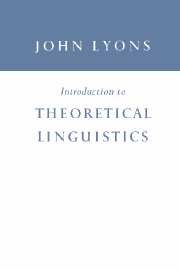Book contents
- Frontmatter
- Contents
- PREFACE TO THE 1995 EDITION
- 1 Linguistics: The Scientific Study of Language
- 2 The Structure of Language
- 3 The Sounds of Language
- 4 Grammar: General Principles
- 5 Grammatical Units
- 6 Grammatical Structure
- 7 Grammatical Categories
- 8 Grammatical Functions
- 9 Semantics: General Principles
- 10 Semantic Structure
- Notes and references
- Addenda
- Bibliography
- Table of symbols and notational conventions
- Index of proper names
- Index of subjects
- Frontmatter
- Contents
- PREFACE TO THE 1995 EDITION
- 1 Linguistics: The Scientific Study of Language
- 2 The Structure of Language
- 3 The Sounds of Language
- 4 Grammar: General Principles
- 5 Grammatical Units
- 6 Grammatical Structure
- 7 Grammatical Categories
- 8 Grammatical Functions
- 9 Semantics: General Principles
- 10 Semantic Structure
- Notes and references
- Addenda
- Bibliography
- Table of symbols and notational conventions
- Index of proper names
- Index of subjects
Summary
Introductory
Phonetics and phonology
So far we have been taking for granted the traditional view of language, according to which sentences are composed of words and words of ‘sounds’ (cf. 2.1.1). In the course of our discussion of substance and form in the previous chapter we saw that the term ‘sounds’ is potentially ambiguous. We must now clear up this ambiguity.
If the linguist is asked whether two ‘sounds’ are the same or different, or how many ‘sounds’ there are in a given language, he must know whether the question is one of substance or form; whether these ‘sounds’ are to be regarded as physical entities which can be described without knowing to what language they belong or whether they are to be described in terms of such differences and similarities of sound as are functional in the language (by ‘functional’ is to be understood ‘relevant for the purpose of communication’). In the first case he will give a phonetic description of what he hears or analyses instrumentally; in the second he will give a phonological description.
Speech-sounds
Let us now distinguish, provisionally, between the terms ‘speechsound’ and ‘phoneme’. A speech-sound is any phonetically distinct unit of sound; that is to say, any unit of sound produced by the speech-organs that can be distinguished by the phonetician from all other units of sound produced by the speech-organs.
- Type
- Chapter
- Information
- Introduction to Theoretical Linguistics , pp. 99 - 132Publisher: Cambridge University PressPrint publication year: 1968



